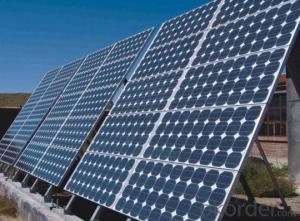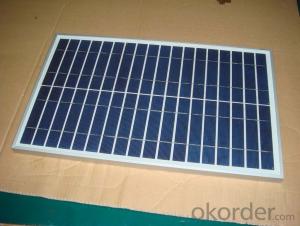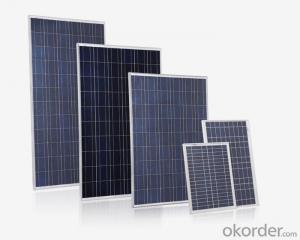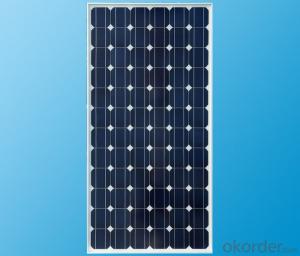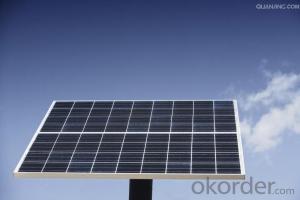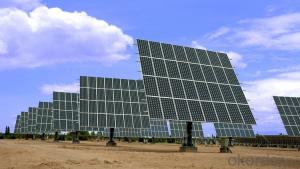Favorites Compare 140w 150w 260w polycrystalline solar panel,polycrystalline silicon solar panel for building automation system
- Loading Port:
- China Main Port
- Payment Terms:
- TT OR LC
- Min Order Qty:
- -
- Supply Capability:
- 10000000000000 watt/month
OKorder Service Pledge
OKorder Financial Service
You Might Also Like
Quick Details
| Place of Origin: | Guangdong China (Mainland) | Brand Name: | CAP | Model Number: | 50w100w150w200w250w300w |
| Material: | Monocrystalline Silicon | Size: | 1385*1035*75mm | Number of Cells: | 72pcs |
| Max. Power: | 300w | type: | solar panel | color: | blue&black |
| warranty: | 5 years |
Packaging & Delivery
| Packaging Detail: | standard export package for solar panel |
| Delivery Detail: | 7-15 days for solar panel |
Specifications
solar panel
High Efficiency
25 years Warranty
High-transmissivity low-iron tempered glass
Solar Panel
50w100w150w200w250w300w
Characteristics
1,High and stable conversion efficienly based on over 4 years professional experience
2 ,High reliability with guaranteed +/-10% output power tolerance
3,Proven materials,tempered front glass,and a sturdy anodized aluminum frame allow modules to operate reliably in multiple mountily configurations
4,Combination of high efficicncy and attractive appearance
Quality and Safety
1,25 year 80%,10 year 90% power warranty 3 year power warranty
2,ISO9001:2000 (Quality Management system) certified factory
3,Product Quality warranty & products Liability Insurance to guarantee and user' benefits
4,Certifications TUV Intercert, CE Temperature Coefficients
| Module Type | 100w | 150w | 200w | 250w | 300w |
| Maximum Power at ST(Pmax)W | 100wp | 150wp | 200wp | 250wp | 300wp |
| Maximum Power Voltage(Vmp)V | 36/18 | 36/18 | 36/18 | 30.8v | 36/18 |
| Maximum Power Current(Imp)A | 2.77/5.55 | 4.16/8.33 | 5.55/11.1 | 8.11A | 8.33/16.66 |
| Open Circuit Voltage(Voc)V | 39.5/19.05 | 39.3/19.4 | 39.6/19.5 | 36.2V | 39.6/19.8 |
| Short Circuit Current(Isc)A | 3.04/6.09 | 4.58/9.16 | 6.1/12.2 | 8.7A | 9.16/18.33 |
| Cell Efficiency(%) | 18.60% | 18.10% | 18.60% | 17.80% | 18.10% |
| Module Efficiency(%) | 17.70% | 17.20% | 17.70% | 17.10% | 17.20% |
| Operating Temperature°C | -40°C to +85°C | -40°C to +85°C | -40°C to +85°C | -40°C to +85°C | -40°C to +85°C |
| Maximum system voltage | 1000V(IEC)DC | 1000V(IEC)DC | 1000V(IEC)DC | 1000V(IEC)DC | 1000V(IEC)DC |
| Power tolerance | -0.03 | -0.03 | -0.03 | -0.03 | -0.03 |
| Temperature coefficients of Pmax | -0.45%/°C | -0.45%/°C | -0.45%/°C | -0.45%/°C | -0.45%/°C |
| Temperature coefficients of Voc | -0.27%/°C | -0.27%/°C | -0.27%/°C | -0.27%/°C | -0.27%/°C |
| Temperature coefficients of Isc | 0.05%/°C | 0.05%/°C | 0.05%/°C | 0.05%/°C | 0.05%/°C |
| Weight(kg) | 8 | 11 | 14 | 20 | 25.5 |
| Number of cell(pcs) | 4*9 | 4*9 | 6*10 | 6*12 | 6*12 |
| Dimensions(mm) | 1194*534*35/30 | 1580*808*50/35 | 1471*670*40/35 | 1640*992*50 | 2000*1050*50 |
- Q:How's the feedback of using 260 watt photovoltaic solar panel? Anybody ever used that?
- The one I am using is up to 19% efficiency. It can be used for 24V home power generation system or grid connected.
- Q:Can solar cells be used for powering electric vehicle charging stations?
- Yes, solar cells can be used to power electric vehicle charging stations. Solar panels can generate electricity from sunlight, which can then be used to charge electric vehicles. This not only promotes the use of renewable energy but also reduces the carbon footprint of electric vehicles by eliminating the need for grid electricity.
- Q:Are there any books in the market t about solar cells and their applications?
- There are a lot of resources about solar cells on line, and they are cheaper.
- Q:What is the role of inverters in solar cell systems?
- The role of inverters in solar cell systems is to convert the direct current (DC) generated by the solar panels into alternating current (AC) that can be used to power household appliances and be fed back into the electrical grid. Inverters also ensure that the solar system operates efficiently by monitoring the voltage and current, maximizing power output, and providing safety features such as ground-fault protection.
- Q:How do solar cells compare to fossil fuel-based power generation?
- Solar cells are a more sustainable and environmentally friendly alternative to fossil fuel-based power generation. Solar cells harness the power of sunlight, a renewable energy source, to generate electricity, while fossil fuel-based power generation relies on the burning of finite fossil fuels like coal, oil, and gas. Solar cells produce clean energy, emit no greenhouse gases, and have little to no impact on climate change. Additionally, while fossil fuel-based power generation requires constant extraction and transportation of fuels, solar cells can be installed in various locations, making them more versatile and accessible. However, solar cells are currently less efficient and more expensive than fossil fuel-based power generation, which hinders their widespread adoption.
- Q:Can solar cells be used in cloudy or rainy weather?
- Yes, solar cells can still be used in cloudy or rainy weather. While their efficiency may be reduced, they can still generate electricity from diffuse sunlight or indirect light. However, their performance will be optimal in direct sunlight.
- Q:Can solar cells be used for powering communication towers?
- Yes, solar cells can be used for powering communication towers. Solar energy can be harnessed using photovoltaic cells, which convert sunlight into electricity. These cells can generate power throughout the day, making them a reliable source of energy for communication towers that require continuous operation. Additionally, solar cells can be integrated with batteries to store excess energy for use during nighttime or cloudy periods, ensuring uninterrupted power supply to communication towers.
- Q:What is the impact of bird nesting on solar cell performance?
- Bird nesting can have a negative impact on solar cell performance as it can lead to shading of the panels, reducing their overall efficiency. Additionally, bird droppings can accumulate on the panels, obstructing sunlight and potentially causing damage to the cells over time. Regular maintenance and prevention measures are necessary to mitigate these effects and ensure optimal solar energy generation.
- Q:What happens to excess electricity generated by solar cells?
- Excess electricity generated by solar cells can be stored in batteries for later use or can be fed back into the grid, allowing others to benefit from the surplus energy.
- Q:What is the environmental impact of manufacturing solar cells?
- The environmental impact of manufacturing solar cells is relatively low compared to other forms of energy production. While the production process does require energy and resources, such as silicon, metals, and chemicals, it is offset by the clean energy the solar cells generate throughout their lifespan. Additionally, advancements in manufacturing techniques have significantly reduced the environmental footprint of solar cell production in recent years. Overall, the environmental benefits of using solar cells for clean energy generation outweigh the impact of their manufacturing.
1. Manufacturer Overview |
|
|---|---|
| Location | |
| Year Established | |
| Annual Output Value | |
| Main Markets | |
| Company Certifications | |
2. Manufacturer Certificates |
|
|---|---|
| a) Certification Name | |
| Range | |
| Reference | |
| Validity Period | |
3. Manufacturer Capability |
|
|---|---|
| a)Trade Capacity | |
| Nearest Port | |
| Export Percentage | |
| No.of Employees in Trade Department | |
| Language Spoken: | |
| b)Factory Information | |
| Factory Size: | |
| No. of Production Lines | |
| Contract Manufacturing | |
| Product Price Range | |
Send your message to us
Favorites Compare 140w 150w 260w polycrystalline solar panel,polycrystalline silicon solar panel for building automation system
- Loading Port:
- China Main Port
- Payment Terms:
- TT OR LC
- Min Order Qty:
- -
- Supply Capability:
- 10000000000000 watt/month
OKorder Service Pledge
OKorder Financial Service
Similar products
New products
Hot products
Related keywords
